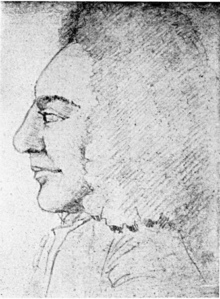Magnus of Bromell
Magnus von Bromell (born March 26, 1679 in Stockholm , † March 26, 1731 there) was a Swedish doctor and mineralogist .
Life
Born Magnus Bromelius and son of the Swedish botanist and doctor Olaf Bromel (also Olof Ole Bromell , 1639–1705), he studied medicine , anatomy , chemistry and botany in Holland, England and France between 1697 and 1704 . He then returned to Sweden and accepted a professorship at the Collegium medicum in Stockholm. In 1724 he was elected its director. In the meantime, Bromell, in his capacity as a trained chemist and mineralogist, was also appointed as an assessor in the Swedish Mining Authority. When Urban Hjärne died four years later, Bromell was appointed as his successor and director of the chemical laboratory.
Together with his father, he created an extensive natural history and numismatic collection. Part of it was taken over to Skånelaholm Castle near Sigtuna . The numismatic collection, however, was acquired by the Swedish Queen Ulrique Éléonore (1688–1741).
Works
Particularly noteworthy among his scientific works is the “Lithographiæ Suecanæ Specimen Secundum” from 1727, which is one of the first scientific works to be exclusively devoted to Swedish fossil and mineral finds. In a geological treatise, he proposes a classification of minerals according to their chemical composition.
Honors
- In 1726 Magnus was ennobled and chose the family name of Bromell.
- A mineral newly discovered in 1925 was named bromellite after him .
literature
- Magnus of Bromell . In: Herman Hofberg, Frithiof Heurlin, Viktor Millqvist, Olof Rubenson (eds.): Svenskt biografiskt handlexikon . 2nd Edition. tape 1 : A-K . Albert Bonniers Verlag, Stockholm 1906, p. 140 (Swedish, runeberg.org ).
Web links
- Curtis P. Schuh: Magnus von Bromell . In: Annotated Bio-Bibliography of Mineralogy and Crystallography 1469-1919 (English)
| personal data | |
|---|---|
| SURNAME | Bromell, Magnus of |
| BRIEF DESCRIPTION | Swedish doctor and mineralogist |
| DATE OF BIRTH | March 26, 1679 |
| PLACE OF BIRTH | Stockholm |
| DATE OF DEATH | March 26, 1731 |
| Place of death | Stockholm |
